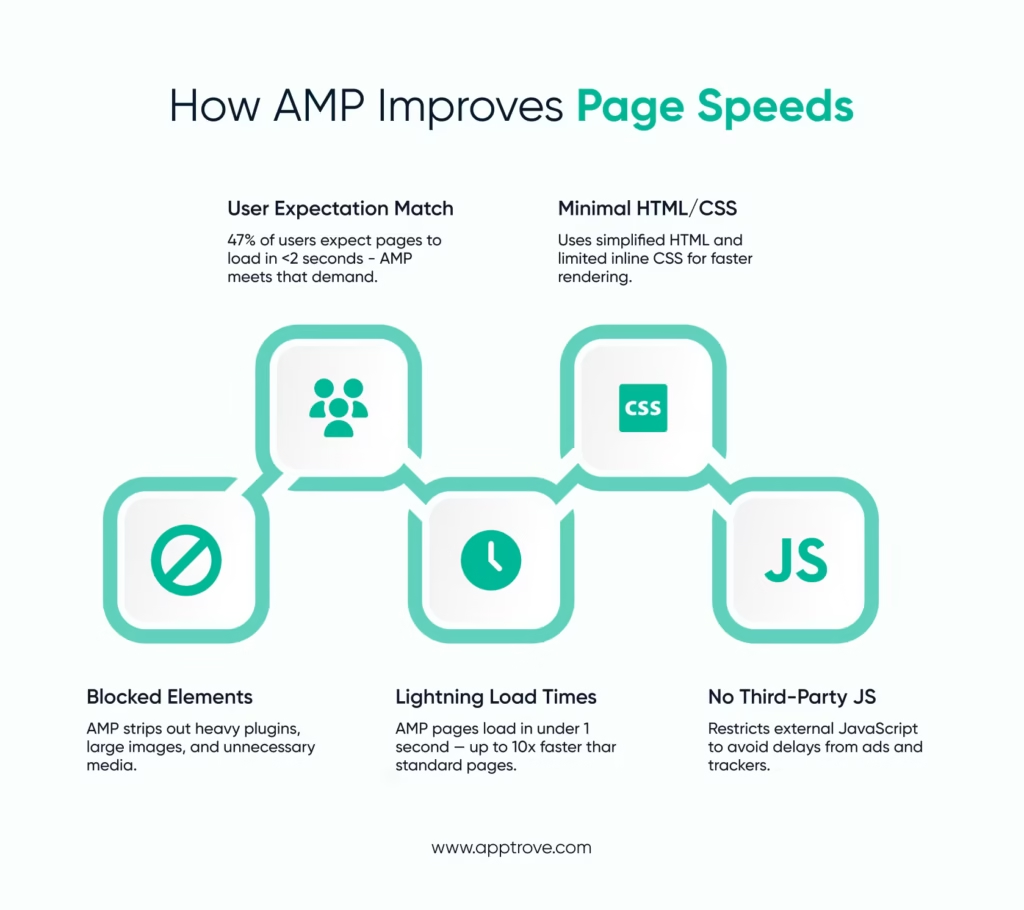What exactly is AMP?
Google and Twitter collaborated on the Accelerated Mobile Pages (AMP) initiative, which was released in 2005. Its goal is to have mobile sites load as quickly as possible. It accomplishes this by removing anything that slows down a website. According to Google, AMP pages shown on Google search load in less than a second (on average) and use ten times less data than their non-AMP equivalent.
If you’re looking for contemporary ways to improve site speed performance beyond AMP, Apptrove offers advanced tools, tactics, and solutions to help companies increase performance, engagement, and conversions.
How Does AMP Work to Improve Page Speeds?

- Plugins, large images, and many pages, as well as JavaScript and other third-party scripts, slow things down. Eliminating or reducing these elements results in a more streamlined website that loads faster.
- According to the Accelerated Mobile Pages study, over 70% of traditional websites take 7 to 10 seconds to load. Accelerated Mobile Pages load in a fraction of a second.
- According to Kissmetrics, 47% of consumers anticipate a page to load in less than two seconds, and 40% will quit a website that takes more than three seconds to open.
- It’s essentially a stripped-down version of HTML code that helps mobile devices to load pages faster. It accomplishes this by removing any unwanted multimedia and rich media elements as well as codes.
- It is, above all, an open-source project. As a result, it features a lot of open components that supporters and enthusiasts may fix and enhance.
What Impact Does AMP Have on SEO?
To begin with, if your site is slow, visitors will not wait for it to load; instead, they will click the back button, quitting your site before seeing it in order to go to a quicker site. If visitors click on your links from search results but then leave within a few seconds, it might hurt your SEO due to a high bounce back rate.
If your web pages are created using Accelerated Mobile Pages, users will see a quick label next to your result on search engine results pages, encouraging them to click on it. As more mobile searchers understand what the sign represents, it’s likely that they’ll choose Accelerated Mobile Pages results over others on a regular basis.
Google favours Accelerated Mobile Pages- enabled web pages over non-Accelerated Mobile Pages-enabled sites. This implies that if you use Accelerated Mobile Pages, your site may rank higher in organic searches. Furthermore, quicker sites generally result in greater conversion rates and engagement metrics.
When Would You Use AMP Pages?
While AMP optimization is critical for creating accelerated mobile pages, it may not be feasible for everyone to implement Accelerated Mobile Pages. Before adopting Accelerated Mobile Pages optimization, there are a few things to keep in mind. Consider the following advantages and disadvantages:
Pros
- Accelerated Mobile Pages speeds up the loading of your website. AMP pages are compact, slick, and lightning-quick, which pleases your visitors and, by extension, Google.
- AMP can assist you in improving your mobile rating. To be clear, Accelerated Mobile Pages isn’t a ranking criterion in and of itself. However, because Accelerated Mobile Pages optimization reduces your site’s load speed, it can have a beneficial influence on your mobile rating. Implementing Accelerated Mobile Pages optimization for your mobile sites will improve your SERP (search engine result page) ranking because quicker load time is a factor in Google’s Core Web Vital page experience metrics.
Cons
- Users must click on the AMP version of a webpage for AMP to operate. The Accelerated Mobile Pages version of your website will not always be the page that appears on the SERP if it is not done appropriately.
- Analytics for tracking data from AMP pages are currently quite restricted. Aside from being rather restricted, Accelerated Mobile Pages requires a separate tag to enable Google Analytics, which must be incorporated into all of your AMP sites in order to effectively gather and analyse data.
- Only one advertisement tag is allowed per page in AMP. Yes, Accelerated Mobile Pages sites allow advertisements; but, owing to the one-ad-per-page constraint, your potential ad income is restricted. Ads on AMP sites are similarly difficult to integrate.
Best Practices for AMP
Are you still thinking about putting Accelerated Mobile Pages on your site? There are several instances where it may be appropriate for your website. Follow these important practices before deploying AMP.
- Check to see whether it’s required for your website: Accelerated Mobile Pages is no longer as beneficial as it once was, so read the section on who AMP is ideal for to determine whether it makes sense for your site.
- If you don’t have WordPress, here’s where you can get help: Although the Accelerated Mobile Pages WordPress plug-in is quite user-friendly, setting it up on your own is not easy. Make contact with a web developer or employ one.
- Don’t use Accelerated Mobile Pages on sites with a lot of traffic or a lot of conversions: Because AMP removes components like opt-in forms and branding, it’s not a good idea to utilise it on sites where you’re trying to establish your brand or create leads.
- To assess if Accelerated Mobile Pages is worth it, do A/B testing: Because AMP allows for A/B and multivariate testing, keep an eye on metrics like conversion rate and time on the page.
Conclusion
When AMP was originally introduced, it drew a large number of advertisers. However, it is becoming obvious that for most websites, the disadvantages of Accelerated Mobile Pagesexceed the benefits. It’s doubtful that AMP will generate more visitors to your site now that it’s no longer a requirement for Top Stories and the Accelerated Mobile Pages mark has vanished from search results.
Rather than focusing on Accelerated Mobile Pages, concentrate on increasing site performance and ensuring that your website is user-friendly on mobile devices. That is the most effective method for attracting mobile consumers and expanding your business.
Want to learn how to improve your site’s performance without AMP? Speak to Sales at Apptrove for expert guidance for your business.
FAQs
1. What types of websites benefit most from AMP?
Accelerated Mobile Pages is ideal for publishers, blogs, and news sites that prioritize speed and readability. These types of sites often place more value on getting the content across than being creative with the design. While there are trade-offs to using Accelerated Mobile Pages, eCommerce and feature-rich sites may find that AMP limits their ability to convert.
2. How does AMP affect user experience on mobile?
By eliminating extraneous elements that can hinder mobile pages from loading, Accelerated Mobile Pages enhances the user experience and enables content to be available almost immediately. Providing content quickly contributes to reductions in bounce rates and higher user engagement. On the contrary, some of that interactivity comes at the cost of continued branding or more robust features offered by standard capabilities.
3. What are the limitations of using AMP for analytics?
Although Accelerated Mobile Pages is designed to help websites load more quickly, it has some limitations in analytics tracking when compared to standard pages. A Google Analytics tag must be added separately, and even with the tag tracking is less granular compared to standard pages. This can make it slightly harder for businesses to accurately measure full user behavior.
4. How can AMP influence advertising revenue?
Accelerated Mobile Pages supports advertisements, but limits them to one tag per page, which can cut revenue potential for publishers. It is also difficult to integrate ads on AMP pages. Page speed can drive engagement, but there is less flexibility with ads, which may not align with sites used primarily for ad revenue.






